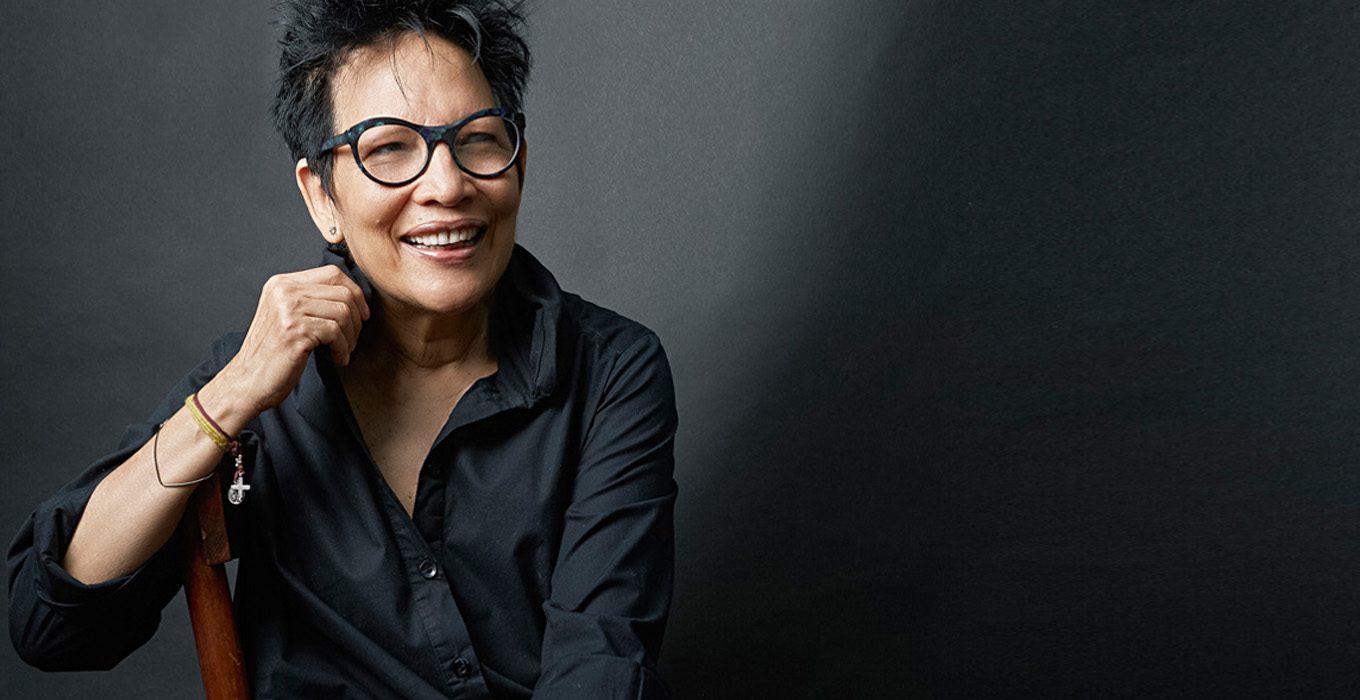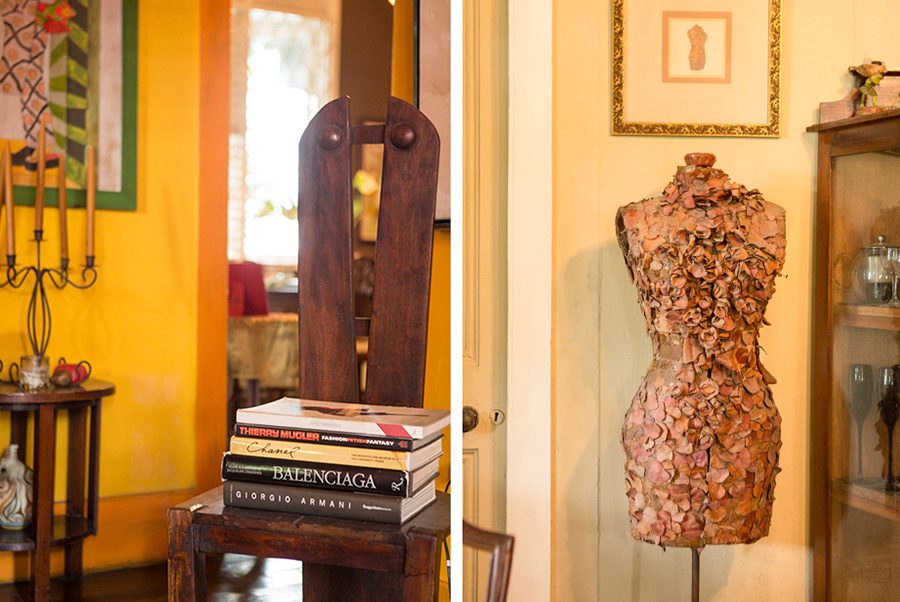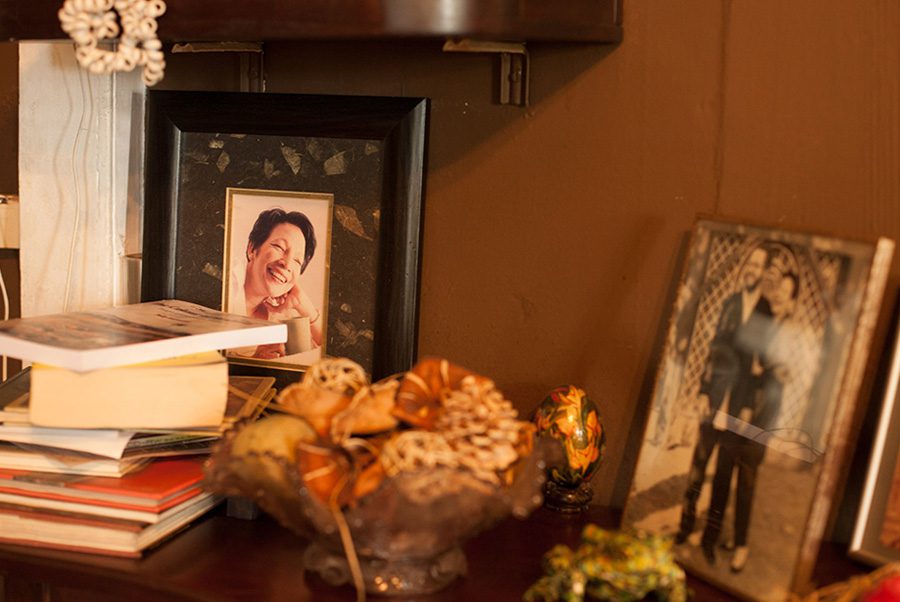

January 14, 2017
“My competition, or your competition, is not a designer who stands next to you in Trinidad. My competition is not Claudia, or Heather, or Robert or an emerging designer. My competition is the world, the whole world.”
I first met Meiling in 2009, while creating her folkloric wonderland of a website. It was a crazy and ambitious project with beautifully dressed douens and dainty la diablesses that slid across a full screen of changing Trinidad scenes. This was a dream job for an aspiring creative who recalled wandering through Meiling’s store, located then at the Kapok hotel, peeking through racks as a child with my fashionable aunt.
Now, almost a decade later, we meet again at her home and studio, which share the same space at 6 Carlos Street, Woodbrook.
With the evolution of social media and Instagram, in particular, we now all get to glimpse inside her sanctuary. But to actually journey within, is an adventure in itself.
A brick and pebble walkway meanders through a lush garden, which reveals her love of anthuriums, leaves and greenery. We stroll the length of her traditional gingerbread style house to make a short stop at her studio then enter her home.
Inside, books are piled high on chairs and ornamental frogs peep out unexpectedly as we journey through the house. And in a surprisingly colourful living room, a clothing rack filled with her designs, possibly for a fitting or photo-shoot looks as well placed as the paintings on the walls by the likes of Che Lovelace and Peter Minshall — just to name a few!
This is the Meiling that new generations of fans are falling in love with.
When did you first fall in love with fashion?
MEILING: Oh, from a very young age. My mother was one of Trinidad’s top dressmakers… My father was the academic and started the Soil Department of the Faculty of Tropical Agriculture, which is now part of UWI. But my mother was a really amazing needlewoman who had basically taught herself, so I grew up in her sewing room, which was our home.
I was always in her sewing room and always fascinated with every Vogue magazine, paper pattern or fabric that came into her space. I was around all the buttons and threads and the whirring machines.
My mother taught me about fabrics and the construction of garments and fine embroidery.
I started beading and embroidering the wedding dresses of some of her clients and I used to plead with the girls in the sewing room to teach me how to sew, but nobody had time for me, so I just had to figure it out.
When did you go on to study fashion formally? What was your parent’s reaction to that?
MEILING: Well as I mentioned before, my father was an academic and couldn’t understand how I would earn a living in fashion. I loved literature and did well at school so I could’ve been a teacher… but the thought alone made me sad because I really wanted to be a fashion designer.
Also, my mother always wanted to study fashion so she was able to encourage my father to send me. The one condition was that I couldn’t go to America; it had to be the UK. So I went to the British Council here in Trinidad, and the Lucie Clayton School of Fashion kept popping up. It was a private school on New Bond Street – not an art college but a finishing school that also included fashion as one of its modules. They taught fashion and it really helped me to hone the skills my mother had already taught me.
What was London in the 60’s like?
MEILING: It was amazing! Being in London in the swinging 60’s, can you imagine? Mary Quant, The Beatles, Vidal Sassoon, The Stones, Otis Redding, Jimmy Hendrix! London was a crazy and exciting time. It was the time of the mini skirts, Twiggy with the painted on eyelashes and Courrège boots.
I was there for four years and worked odd jobs in the summer. I was a flower child with long dresses and long hair, enjoying this vibrant age. And up to this day, I still think London has the best street fashion!
It must have been a crazy transition to come back home after college ended?
MEILING: Yes… I cried for a year when I returned! Because, to begin with, you were living in London in a basement apartment having a wild time with all these musicians, artists and other fashion students. All of our friends were artists. So to come back to Trinidad, to come home and live with my parents was such a change!
When I returned, my mother still had her dressmaking business and she said to me, “So you know you have to go and find a job?” I asked, “But where do I find a job?” She said, “I don’t know, but go and find a job!”
I can’t even imagine what Trinidad was like then!
MEILING: At that time, it was dated in terms of trends but the industry was much more alive! We were a few years behind international fashion but we were making and exporting to the rest of the Caribbean, because there was something called the “negative list” which prevented the importation of garments to Trinidad.
So, I went with my portfolio looking for a job and was lucky to be employed by a company on Queen Street as a pattern maker/grader. There was a lady who would sit and make whatever design you wanted: you do everything else. It was really mundane but the garment industry was well and alive.
Were there any creative opportunities there at all?
MELING: Well we would meet in the design room and I and another young designer would present our designs. But my dresses were always too fashion-forward for them so they were rejected.
Then, one day, I did a design with a fabric called double knit, which was the neoprene fabric of the time. It was very synthetic. I designed something very simple: a beautiful coat-dress and they loved it… They must have made thousands of because it was such a good seller!
When did you leave and open your own store?
MEILING: In 1969! My aunt had this house at Flarent Street with a small room. And she said, “I will rent you this and you can open your boutique.” So, I did!
So this is where I guess things start to fall into place?
MEILING: Yes… I actually returned to Trinidad at the right time so I was able to give young women fashion that was up to date, and people like Hazel Ward and other celebrities wore and bought my clothes, endorsing me.
Then I moved shop. I was still manufacturing at my mother’s home in St. Augustine and the logistics of going to and fro became difficult. So I found this super studio apartment where I lived and worked – at the top of Abercromby Street, near Bishop’s – and I had three ladies sewing with me.
Interestingly enough, this apartment was Minshall’s father’s studio. As a child, I would visit my aunt who lived next door and was fascinated by this man who would spend his day painting at his easel. From that time, I consciously began building my brand. I got up very early each morning, went to my studio, did my work and produced two collections a year. As I said, the timing was right.
Can we talk about what you think a Caribbean Designer is, and what that means to you?
MEILING: I think Robert Young of The Cloth is the designer of the Caribbean. He’s a genius and he’s the only Caribbean designer I wear besides my own.
I think of myself first, as a designer; second, as a designer who happens to live in the Caribbean, not designing Caribbean fashion. I am very much influenced by the Caribbean and I always want to work in cottons or linens because of where we live. But if a visitor or tourist bought my garments and returned to their city, it shouldn’t scream like a Hawaiian shirt that it’s from Trinidad & Tobago. It must be able to stand up on its own in any city – in Europe, wherever – and be admired for what it is.
They may then ask, “So, who are you wearing?” And the person would say, “Oh, it’s a Caribbean designer and all the detailing is done by hand and it’s cotton or linen because of where she works.”
When you think about Caribbean design now and Caribbean based designers, the idea of what that means has expanded so much; while we’re in this geographic location, we’re also inspired by and exposed to a lot of influences. We’re part of the world: not in a bubble, not on an island by ourselves.
MEILING: You know what I tell my interns? Especially now, with social media, is that,
“My competition, or your competition, is not a designer who stands next to you in Trinidad. My competition is not Claudia, or Heather, or Robert or an emerging designer. My competition is the world, the whole world.”
But are you influenced by the Caribbean?
MEILING: There’s no doubt about it! I’m influenced by the Caribbean, by Trinidad…
Every artist is influenced by his or her environment, to a certain extent. And when I think Caribbean, I don’t only think Carnival and bright colours, I love the flora of Trinidad – I have to have anthuriums in my home and leaves! I love leaves! – I’m also so inspired by the architecture of Trinidad!
I am also curious about everything: other people, other countries, how people live, and their cultures. As a creative person, that also permeates my work at some level. I might be listening to some music at a certain time or looking at something, and that subconsciously inspires my work.
In my career, my goal is always to remain relevant. I enjoy having interns and young creatives of this generation around me so much more than my peers, because some of them get stuck.
So, I could listen to the music of my interns and not necessarily have to like the music, but I’m curious to hear what they’re listening to, what films they’re watching and what books they’re reading so I’ll always be relevant, especially now.
Think about it. I’ve been working 47 years and I’m now dressing children, grandchildren and great grandchildren of my original clients.
So, I have to get a whole new generation to buy into the brand and it’s happening slowly. I know a lot of it is a generation thing. If their mother or grandmother has worn my stuff, they’ve been hearing the name and by natural progression they will continue to wear my design. But it is a challenge. Especially, I feel more challenged because of this whole Kardashian thing, and it is hard for people to appreciate a good linen shirt, but I don’t give up because I still see myself influencing the fashion scene.
You have a strong presence on Instagram. We get glimpses of not only your work via the medium, but your studio and your garden, and we feel like we get a sense of you when you share quotes and your loves.
MEILING: A lot of people do not know and believe that I have an Instagram account. They were saying that, “Meiling could never manage her own Instagram account” and I said, “Yes. I do!” And I love doing it and I know it’s working because it’s coming from my heart. They want to know what makes me tick and I’ve grown my client base because of this.
Instagram is fascinating. On the one hand, it’s this great marketing and self-expression tool – you could even say a creatively inspiring tool. And on the other, it can be a really crazy self-indulgent space that’s not very positive…
MEILING: Wendell Manwarren had lunch with me this week: it was Wendell, Robert Young and myself. So, you could imagine how interesting that conversation was! And he was saying that the Millennials now feel so big: nobody wants to work, they just want instant gratification, instant fame, instant everything… And it’s all about social media, you know. We can’t blame them. It’s the selfies. So, I tell them,
“Likes don’t translate into dollars.”
Tell us a bit about your relationship with your interns. You seem to have interns very often…
MEILING: Interns would have been coming for the last five or six years. I tell every intern, “When you come to work with me, you either swim or sink. I don’t have time to stop.”
I do everything: from my Instagram in the morning, to packing the boxes, to sweeping the floor. Everything! So, you just have to find your way.
I want Carlos Street to be known as an open door to all creative because I enjoy mentoring: I want that to be part of my legacy. On Saturday mornings, I meet with my protégés and new creatives and I just listen. If they want to come in here and spend the day, that’s fulfilling for me. I don’t just want to be a designer in the Caribbean: I want to be open.
I love that your work is your passion and clearly makes you happy but what else makes you happy?
MEILING: My luxury is silence. On Sundays, I hate people to ask me out! I love being by myself. I love to read. For my birthday, I went to Costa Rica and spent two weeks of silence with my yoga teacher. You completely switch off the world. No television, no social media. All you do is meditate and go deep into the silence and just shed your layers. I live a very simple life…
“My luxury is silence.”
What’s the future of the Meiling brand?
MEILING: You know, people ask me, “What do you want now?”
I want to continue working as a designer so I can continue to produce and expand my brand. I want to continue collaborating with other creatives. And, my mother lived to be 99, so I’m going to work and work and work…
Thank you Meiling for taking the time to share your thoughts and your dreamy home and studio with us.






INTERVIEWER: TANYA MARIE Photographer: KIBWE BRATHWAITE